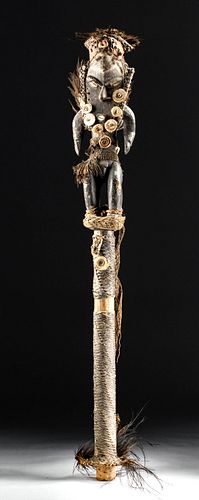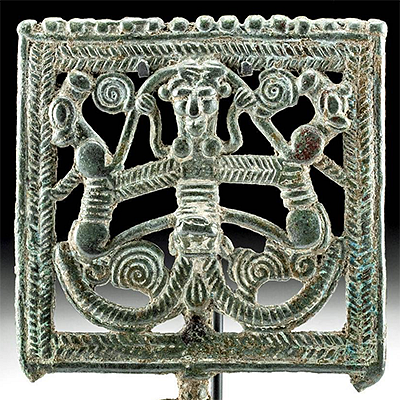19th C. Papua New Guinea Bamboo Flute w/ Wood Stopper
Lot 102a
About Seller
Artemis Fine Arts
686 S Taylor Ave, Ste 106
Louisville, CO 80027
United States
Selling antiquities, ancient and ethnographic art online since 1993, Artemis Gallery specializes in Classical Antiquities (Egyptian, Greek, Roman, Near Eastern), Asian, Pre-Columbian, African / Tribal / Oceanographic art. Our extensive inventory includes pottery, stone, metal, wood, glass and textil...Read more
Categories
Estimate:
$1,500 - $2,500
Absentee vs Live bid
Two ways to bid:
- Leave a max absentee bid and the platform will bid on your behalf up to your maximum bid during the live auction.
- Bid live during the auction and your bids will be submitted real-time to the auctioneer.
Bid Increments
| Price | Bid Increment |
|---|---|
| $0 | $25 |
| $300 | $50 |
| $1,000 | $100 |
| $2,000 | $250 |
| $5,000 | $500 |
| $10,000 | $1,000 |
| $20,000 | $2,500 |
| $50,000 | $5,000 |
| $100,000 | $10,000 |
| $200,000 | $20,000 |
About Auction
By Artemis Fine Arts
Nov 5, 2020
Set Reminder
2020-11-05 10:00:00
2020-11-05 10:00:00
America/New_York
Bidsquare
Bidsquare : Ancient & Ethnographic From Around the World
https://www.bidsquare.com/auctions/artemis-gallery/ancient-ethnographic-from-around-the-world-5916
Ancient art from Egypt, Greece, Italy and the Near East, as well as Asian, Pre-Columbian, Native American, African / Tribal / Oceanic, Spanish Colonial, Russian Icons, Fine art, much more! All categories, all price ranges... all legally acquired and guaranteed to be as described or your money back. Artemis Fine Arts info@artemisfinearts.com
Ancient art from Egypt, Greece, Italy and the Near East, as well as Asian, Pre-Columbian, Native American, African / Tribal / Oceanic, Spanish Colonial, Russian Icons, Fine art, much more! All categories, all price ranges... all legally acquired and guaranteed to be as described or your money back. Artemis Fine Arts info@artemisfinearts.com
- Lot Description
Oceania, Papua New Guinea, Sepik River, Yuat River, Biwat people, ca. late 19th to early 20th century CE. An impressive bamboo flute topped with a hand-carved wooden figural stopper, depicting a man wearing a mask, crouching with arms bent to his sides. The long-faced mask features two petite cowrie snail shells as slanted eyes, topped with feathered lashes and surrounded by heavy lids and another for its mouth as a red septum piercing adorns its sharp nose. Decorated with volute shells and braided reeds on the bottom perimeter of his mask, the fun figure additionally wears a half-moon headdress decorated with another braided reed, shells, a black clay-like material, and feathers atop his extended forehead and coiled hair (which, by the way, is made from real human hair!), as well as a woven shell belt on his slim waist, a feathered loin cloth over his genitalia, and plaited reed anklets. Interwoven rope is tied around the small plinth atop the tall bamboo stalk flute which showcases entwined reeds, a sliced gastropod shell, and a loop of small shells laced together. The circular base of this musical instrumant is further embellished with long feathers. Lovely shades of chocolate, sienna, and beige add detail and depth to this excellent example from Papua New Guinea! Size: 7.25" W x 51.5" H (18.4 cm x 130.8 cm)
"For many New Guinea peoples, flutes are, or were, among the most sacred and important of all musical instruments. Sacred flutes were often made from hollow cylinders of bamboo and played, like a Western flute, by blowing through a hole in the side of the instrument near the upper end. The tops of side-blown flutes were frequently sealed with ornamental flute stoppers. Some of the finest flute stoppers were made by the Biwat people of the Yuat River in northeast New Guinea. Biwat flute stoppers typically portray stylized human images with small bodies and large heads with extremely high domed foreheads. Although they depict human figures, the stoppers adorned ashin, flutes associated with crocodile spirits. Ashin flutes were used, in part, during initiation rites in which novices crawled into the mouth of a large crocodile effigy to be cut by its teeth. The teeth, actually sharp implements wielded by the initiators, made cuts that healed into permanent scarification patterns on the novices’ bodies, marking them as initiated individuals." (The Metropolitan Museum of Art website)
Provenance: private Orange, California, USA collection, acquired in the 1930s
All items legal to buy/sell under U.S. Statute covering cultural patrimony Code 2600, CHAPTER 14, and are guaranteed to be as described or your money back.
A Certificate of Authenticity will accompany all winning bids.
We ship worldwide and handle all shipping in-house for your convenience.
#159670Flute and stopper have been attached and holes of flute are covered. Two collection labels on bottom interior of flute. Some chipping and fading to paint, but excellent remaining pigment. Slight loss to feathers and hair. One shell missing on proper right side of mask. Otherwise, intact and excellent.Condition
- Shipping Info
-
All shipping is handled in-house for your convenience. Your invoice from Artemis Gallery will include shipping calculation instructions. If in doubt, please inquire BEFORE bidding for estimated shipping costs for individual items.
-
- Buyer's Premium



 EUR
EUR CAD
CAD AUD
AUD GBP
GBP MXN
MXN HKD
HKD CNY
CNY MYR
MYR SEK
SEK SGD
SGD CHF
CHF THB
THB
















